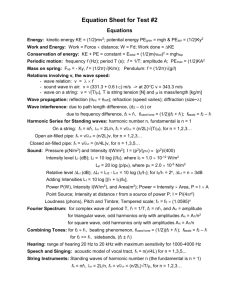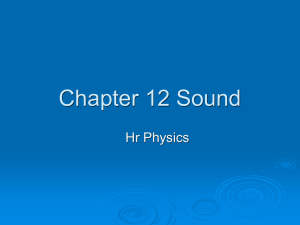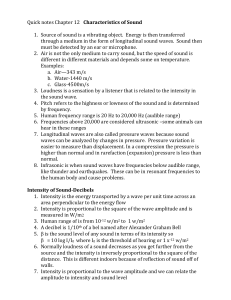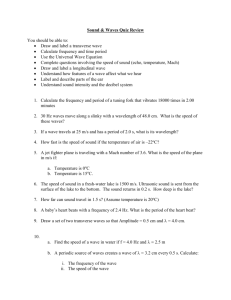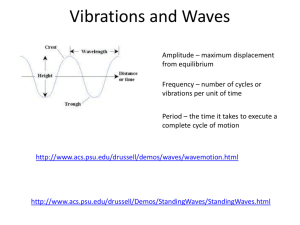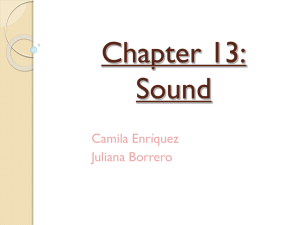Holt Physics Chapter 13
advertisement
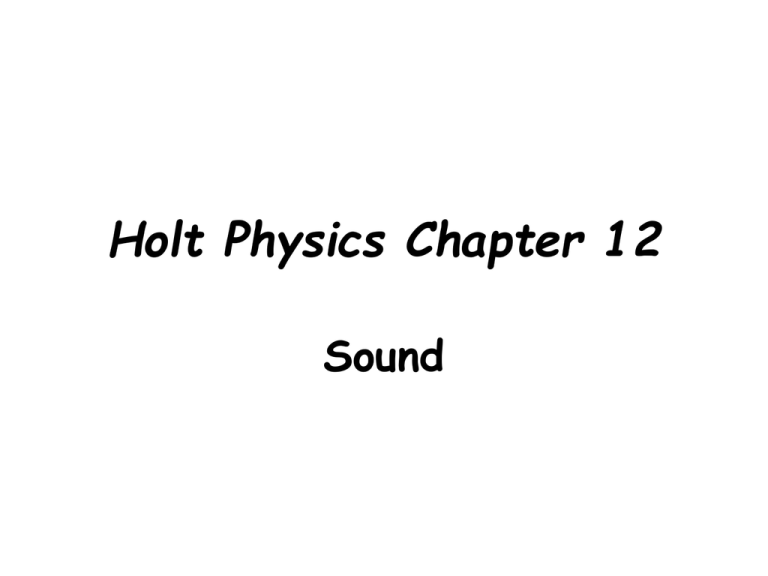
Holt Physics Chapter 12 Sound The Production of Sound Waves All sound begins with a vibrating object Produces compression (high molecular density and high air pressure) and rarefaction (low molecular density and low air pressure) Sound waves are longitudinal waves. Audible sound waves have frequencies between 20 and 20,000 Hz. Less than 20 Hz are infrasonic Elephants use these to communicate Above 20,000 Hz are ultrasonic Dogs can hear these and used for ultrasounds (object > wavelength) Pitch – how high or low we perceive a sound to be – determined by frequency. Speed of Sound Waves, General The speed of sound waves in a medium depends on the compressibility and the density of the medium. Speed of Sound Sound travels through solids and liquids and gases at different speeds. See pg. 407 Speed of Sound in Air The speed of sound also depends on the temperature of the medium This is particularly important with gases Shock Wave The speed of the source can exceed the speed of the wave The envelope of these wave fronts is a cone Shock Wave The conical wave front produced when vsource > vsound is known as a shock wave This is supersonic Dimensions of sound Sounds propagate in three dimensions A small source of sound is assumed to be spherical wave fronts (areas of compression) each one wavelength apart. 3d representation Shading represents density wave fronts rays Dimensions of sound At large distances relative to the wavelength, we will assume rays of sound are parallel. (see pg. 407-8) Sound Consider a vibrating guitar string Piece of string undergoes harmonic motion String Vibrates Molecules fly out with varying density Sound Now consider your ear Nerves tell brain “sound!” Eardrum vibrates Sound Consider the actual air molecules and their motion versus time, time 0 time 1 time 2 Individual molecules undergo harmonic motion with displacement in same direction as wave motion. Waves, Wavefronts, and Rays Doppler Effect In general, relative motion creates a change in frequency Although the source frequency remains constant, the wave fronts are compressed – higher frequency - (when moving toward) and stretched – lower frequency - (when moving away) – see pg.408 This is how police radar systems work. Doppler Effect, Source Moving Formative Assessment pg. 409 Sound Level The range of intensities detectible by the human ear is very large It is convenient to use a logarithmic scale to determine the intensity level Sound Intensity Sound intensity is the rate at which the energy of a sound wave is transferred through a unit area of the plane wave (wave front). Power (P) is used to define the rate of energy transfer, so Intensity = P/area…which translates for a spherical wave front to be Intensity= P/4r2, where r is the distance from the source. Unit Watts/m2 Example 1 What is the intensity of the sound waves produced by a speaker at a distance of 350 cm when the power output of the speaker is 0.80Watts? Given: P=0.80W r=350cm=3.5m Unknown: Intensity=? Intensity = P/4r2 Intensity = 0.80W/(4(3.5m)2) I = 5.2X10-3 W/m2 Example 2. The power output of an explosion is 320 W. At what distance is The intensity of the sound 1.5 x 10-3 W/m2 ? P 320 W r 130 m -3 2 4I 4 (1.5 x 10 W/m ) Example 3. How much power is radiated as sound from an alarm that has an intensity of 1.1 x 10-4 W/m2 at a distance of 12 m? P 4r 2 I (4 )(12 m) 2 (1.1 x 10 -4 W/m 2 ) 0.20 W Concepts… You are standing 10 m away from a very loud, small speaker. The noise hurts your ears. In order to reduce the intensity to 1/2 its original value, how far away do you need to stand? I=P/4r2 (a) 14 m (b) 20 m (c) 30 m (d) 40 m Concepts You are standing 1 m away from a very large wall hanging speaker. The noise hurts your ears. In order to reduce the intensity you walk back to 2 m away. What is the ratio of the new sound intensity to the original? (a) 1 speaker (b) 1/2 (c) 1/4 1m (d) 1/8 I=P/4r2 Sound Intensity and Frequency Intensity and frequency determine which sounds are audible. See pg. 412 Decibel level is determined by relating the intensity of a sound wave to the intensity at the threshold of hearing. In general, a 10 dB increase is equivalent to doubling the volume. Resonance Every pendulum has a natural frequency that depends on its length. Resonance – a condition that exists when the frequency of a force applied to a system matches the natural frequency of vibration of the system. Earthquakes and winds can cause resonance. (see page 415) Resonant Motion Consider the following set of pendula all attached to the same string A D B C If I start bob D swinging which of the others will have the largest swing amplitude ? (A) (B) (C) Dramatic example of resonance In 1940, turbulent winds set up a torsional vibration in the Tacoma Narrow Bridge when it reached the natural frequency it collapsed ! Practice pg. 411 and Formative Assessment pg. 416 Standing waves on Vibrating Strings Remember…on a rope fixed at both ends, a variety of standing waves can occur (with nodes at each end). 1=2L 2=L 3=2/3 L f=v/ Fundamental frequency=f1=v/ 1 =v/2L Always the lowest possible frequency Resonance Lab Harmonics on a Vibrating String or Open Pipe Harmonics (f1, f2 etc… ) are integral multiples of the fundamental frequency 2=L so f2=2f1 etc…see pg. 419-20 These frequencies form what is called a harmonic series. Formula fn =n•v/2L n=1,2,3… Lesson 13-3 Harmonics Example 1. A violin string that is 60.0 cm long has a fundamental frequency of 480 Hz. What is the speed of the waves on this string? 2Lf 2(0.600 m)(480 Hz) 580 m/s n 1 Lesson 13-3 Harmonics Example 2. What is the fundamental frequency of a 40.0 cm guitar string when the speed of waves on the string is 135 m/s ? n (135 m/s)(1) f 169 Hz 2L 2(0.400 m) Standing waves on a Closed Pipe For a closed pipe (one end), there is a node at the closed end and an antinode at the open end. 1 =4L Formula fn =n•v/4L n=1,3,5… Only odd harmonics…since the second harmonic is 3X the first…so we call it f3 See page 421 Example 3. What is the fundamental frequency of a 0.40 m long organ pipe that is closed at one end, when the speed of sound in the pipe is 354 m/s? n (354 m/s)(1) f 220 Hz 4L 4(0.40 m) Example 4 (book example) What are the first three harmonics in a 2.45m long pipe that is open at both ends? What are the first three harmonics of this pipe when one end of the pipe is closed? Use 345m/s for the speed of sound in air. L=2.45m v=345m/s Pipe open f1, f2, f3 Pipe closed f1, f3, f5 Open: fn=nv/(2L), n=1,2,3… Closed: fn=nv/(4L), n=1,3,5… Open f1=(1)345/(2(2.45m)) = 70.4Hz f2 =(2)345/(2(2.45m)) = 141 Hz f3 =(3)345/(2(2.45m)) = 211 Hz Closed f1=(1)345/(4(2.45m)) = 35.2Hz f3 =(3)345/(4(2.45m)) = 106 Hz f5 =(5)345/(4(2.45m)) = 176 Hz Practice page 423 Harmonics A tuning fork only vibrates at its fundamental frequency… Other instruments, however, consist of many harmonics, each at different intensities. Instruments From the fundamental frequency, the chromatic (half-step) consists of 12 notes, and the 13th is the frequency of the second harmonic. This constitutes a complete octave. Beats(alternation between LOUD – complete constructive interference and SOFT – complete destructive interference) are heard when two notes are slightly different frequencies. This is used to tune an instrument The number of beats per second corresponds to the difference between frequencies in Hertz. If one frequency is 257Hz and the other is 265 Hz, you would hear 8 beats per second. You cannot tell whether it is 8 beats higher or lower, except by first determining relative pitch. Formative Assessment pg. 427

